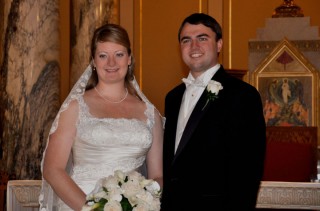
Courtesy Photo
By Liz Cohen
Contributor
He surprised her with rose petals. Candles lit. Chairs arranged to watch the sunset.
On June 20, 2009, Martin Frank proposed to Mary Kolner on the old water tower at Mother Neff State Park, a spot they both loved.
Martin and Mary received presidential doctoral scholarships upon coming to Baylor. These scholarships enabled them to meet in February 2007, when they were introduced at a luncheon for doctoral scholars.
Although Mary’s studies in English literature and Martin’s research in physics might seem to make them intellectual and emotional opposites, that didn’t prove to be the case.
“Everyone who comes together at those luncheons has so much in common, in terms of shared values and a true passion for intellectual life,” Mary said.
These shared interests made it possible for Martin and Mary to discover they have much in common.
“It was pure accident,” Mary said.
All the first-year presidential scholars were giving speeches about their academic goals for that year. The man who spoke before Martin mentioned Mary’s alma mater, the University of Dallas. After the meal, Mary introduced herself to the undergraduate, and Martin was sitting next to him, so she ended up speaking to both of them.
“Plus, I like to think the spirit of my alma mater was hovering over the situation,” Mary said.
Soon after they met, Martin moved to Chicago for a year to work at Fermilab as part of his research. During this time, the two continued to communicate long distance, and soon their relationship became more serious. They started dating and later married on Aug. 7, 2010.
Martin, originally from Munich, Germany, researches high-energy particle physics. His dissertation is about the Higgs boson, which involves figuring out how to explain mass mathematically.
He conducts his study via Fermilab, using a collider detector. “It’s very pure science. That’s what I love about it. The very fundamental level,” Martin said.
Mary, from Ames, Iowa, specializes in Victorian literature. She originally came to Baylor to study modernist literature, but realized that, “I was really a Victorianist running around pretending that I wasn’t.” She said conflict of faith and doubt in the Victorian period fascinated her.
Her dissertation focuses on the writings and influences of John Henry Newman.
“I’ve received so much individual encouragement and attention from my teachers here as a student and have never been given an impression that I’m taking away from a faculty member’s research time,” Mary said.
Martin graduated in May and is applying for post-doctoral positions. He hopes to someday return to a university and become a professor. Since post-doctoral positions for the humanities are harder to find, Mary plans to follow Martin and find a temporary teaching position. After she writes her dissertation, she’ll graduate in late 2012.
“We would love to work at a university like Baylor where the teaching of undergraduates is highly valued,” Martin said. They both want to teach at a research university with a vibrant and active graduate program. But no matter what, Martin and Mary will be together.
“It’s been a beautiful experience to be here,” Martin said. “I’ll definitely miss my colleagues when I leave.”






